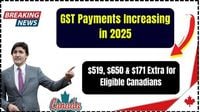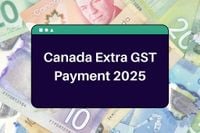Canadians are gearing up to receive their second GST credit payment of 2025 this week, with eligible individuals set to see extra cash in their bank accounts on Friday, April 4. The Goods and Services Tax (GST) and Harmonized Sales Tax (HST) credit is designed to assist families with low to moderate incomes in offsetting the taxes they pay on everyday purchases. This financial relief comes at a crucial time as inflation continues to impact household budgets.
To qualify for the GST payment, individuals must be at least 19 years old and a Canadian resident for income tax purposes as of a month before the Canada Revenue Agency (CRA) issues the payment. For those under 19, eligibility hinges on having a spouse or common-law partner, or being a parent living with their child. Notably, parents sharing custody may be eligible for half the credit for that child.
The government outlines potential payment amounts for 2025: single individuals can receive up to $519, married or common-law couples can get up to $680, and families with children under 19 can receive $179 for each child. These payments are part of a broader strategy to alleviate the financial strain on Canadians facing rising living costs.
In 2022, the Canadian government temporarily doubled the GST credit for six months in response to soaring inflation, highlighting the ongoing need for financial assistance among lower-income households. This year, the government is continuing its efforts with increased GST payments, which are issued quarterly. The next payment is scheduled for April 4, 2025.
The CRA automatically assesses eligibility for the GST/HST credit when individuals file their tax returns, which means no separate application is necessary. However, it is crucial for individuals to file their tax returns accurately and on time, even if they have no income, to ensure they receive their payments promptly.
For those who may miss a payment or fail to apply, the consequences can be significant. The CRA does not offer retroactive payments, meaning any missed installment results in a complete loss of that quarter’s payment. Additionally, individuals who do not update their information with the CRA regarding changes in marital status or income may face delays or inaccuracies in their payments.
As Canadians await the upcoming GST payment, many are also looking forward to Canada’s final carbon rebate, which is another financial relief measure aimed at easing the burden of rising costs. This rebate, along with the GST credit, serves as a crucial lifeline for many households.
To maximize the benefits of the GST/HST credit, Canadians are encouraged to ensure their tax filings are accurate and up-to-date. Utilizing direct deposit can also expedite the receipt of payments, allowing individuals to access their funds more quickly. Keeping abreast of changes in personal circumstances and promptly informing the CRA can prevent potential issues with payment eligibility.
In summary, the GST credit payments are a vital component of the Canadian government's strategy to support low- and moderate-income families. With increased payment amounts and an automatic application process, eligible Canadians can look forward to receiving this much-needed financial assistance.








